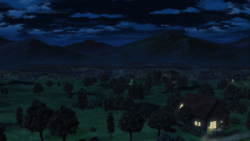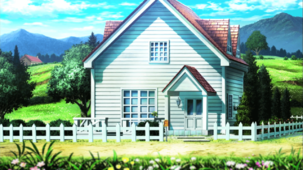
|
This article is incomplete.
Please feel free to edit this article to add missing information and complete it.
Reason: Needs LGPE layout image
|
| Pallet Town
|
マサラタウン
Masara Town
|
| "Shades of Your Journey Await!"
|
|
|
|

Pallet Town in {{{variable2}}}.
|
|
Map description
A fairly new and quiet town. It's a small and pretty place.HGSS
A small country town, home to Professor Oak's lab.PE
|
|
|
[[|Pallet Town Gym]] - Kanto Gym #{{{gymno}}}
[[File:{{{leadersprite}}}|{{{leader}}}|link={{{leader}}}]]
[[{{{leader}}}|{{{leader}}}]]
|
No specialty type
|
[[File:{{{badge}}} Badge.png|70px|{{{badge}}} Badge|link=Badge#{{{badge}}} Badge]]
[[Badge#{{{badge}}} Badge|{{{badge}}} Badge]]
|
|
[[|Pallet Town Gym]] - Kanto Gym #{{{gymno}}}
[[File:{{{leadersprite2}}}|{{{leader2}}}|link={{{leader2}}}]]
[[{{{leader2}}}|{{{leader2}}}]]
|
Unknown-type
specialist Gym
|
[[File:{{{badge}}} Badge.png|70px|{{{badge}}} Badge|link=Badge#{{{badge}}} Badge]]
[[Badge#{{{badge}}} Badge|{{{badge}}} Badge]]
|
|
[[|Pallet Town Gym]] - Kanto Gym #{{{gymno}}}
[[File:{{{leadersprite3}}}|{{{leader3}}}|link={{{leader3}}}]]
[[{{{leader3}}}|{{{leader3}}}]]
|
Unknown-type
specialist Gym
|
[[File:{{{badge}}} Badge.png|70px|{{{badge}}} Badge|link=Badge#{{{badge}}} Badge]]
[[Badge#{{{badge}}} Badge|{{{badge}}} Badge]]
|
|
[[| League]]
[[File:{{{elite1sprite}}}|64px|{{{elite1}}}|link={{{elite1}}}]]
Elite Four
[[{{{elite1}}}|{{{elite1}}}]]
|
[[File:{{{elite2sprite}}}|64px|{{{elite2}}}|link={{{elite2}}}]]
Elite Four
[[{{{elite2}}}|{{{elite2}}}]]
|
[[File:{{{elite3sprite}}}|64px|{{{elite3}}}|link={{{elite3}}}]]
Elite Four
[[{{{elite3}}}|{{{elite3}}}]]
|
[[File:{{{elite4sprite}}}|64px|{{{elite4}}}|link={{{elite4}}}]]
Elite Four
[[{{{elite4}}}|{{{elite4}}}]]
|
[[File:{{{championsprite}}}|{{{champion}}}|link={{{champion}}}]]
Champion [[{{{champion}}}|{{{champion}}}]]
|
|
[[| League]]
[[File:{{{elite1sprite2}}}|64px|{{{elite12}}}|link={{{elite12}}}]]
Elite Four
[[{{{elite12}}}|{{{elite12}}}]]
|
[[File:{{{elite2sprite2}}}|64px|{{{elite22}}}|link={{{elite22}}}]]
Elite Four
[[{{{elite22}}}|{{{elite22}}}]]
|
[[File:{{{elite3sprite2}}}|64px|{{{elite32}}}|link={{{elite32}}}]]
Elite Four
[[{{{elite32}}}|{{{elite32}}}]]
|
[[File:{{{elite4sprite2}}}|64px|{{{elite42}}}|link={{{elite42}}}]]
Elite Four
[[{{{elite42}}}|{{{elite42}}}]]
|
[[File:{{{championsprite2}}}|{{{champion2}}}|link={{{champion2}}}]]
Champion [[{{{champion2}}}|{{{champion2}}}]]
|
|
|
|
Location
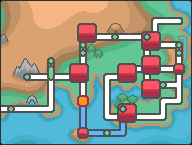
Location of Pallet Town in Kanto.
|
|
|
Pallet Town (Japanese: マサラタウン Masara Town) is a small town located in southwestern Kanto. It is the hometown of the player and their rival in the Kanto-based games. In other games, it is specifically the hometown of Red and Blue. In the anime, it is the hometown of Ash and Gary. Professor Oak's Laboratory, where the famous Professor Oak conducts his research, is located in the town.
The town has two exits. To the north is Route 1, leading to Viridian City. To the south is Route 21, a water route leading to Cinnabar Island.
Slogan
Generations I and III
Shades of your journey await! (Japanese: マサラは まっしろ はじまりのいろ Masara is the color of pure-white beginnings.)
Generation II
A Tranquil Setting of Peace and Purity (Japanese: マサラは まっしろ けがれなき いろ Masara is colored with pure white.)
Generation IV
A Pure White Beginning (Japanese: まっしろ はじまりの いろ The color of pure-white beginnings.)
Generation VII
Shades of Your Journey Await! (Japanese: マサラは まっしろ はじまりのいろ Masara is the color of pure-white beginnings.)
Places of interest
Professor Oak's Lab
- Main article: Professor Oak's Laboratory

Inside the lab in HeartGold and SoulSilver
In the southeast corner of town is Professor Oak's Lab. Here, Pokémon Trainers just beginning their quest are given the choice to receive either a Bulbasaur, Charmander, or Squirtle from Professor Oak. On the occasion that Professor Oak is out of the previously listed Pokémon, he has been seen to hand out Pikachu and Eevee. This is also the location of the player's first battle, which was against their rival, BlueRBYFRLG or TracePE.
The lab is a small building near the player's house that has been slightly modified in every game. In Pokémon Red and Blue the sign says "Here is the Institute of Dr. Okido." in Japanese, and "Oak Pokémon Research Lab" in the English language versions. Inside are three of Professor Oak's aides, two men and one woman, a couple of shelves full of books, a table with three Poké Balls, a computer, two blank Pokédexes, and two tips for the player. In Pokémon Yellow the lab is the same as Red and Blue, except there is only one Poké Ball on the table, and next to the table stands a trash can. In Pokémon FireRed and LeafGreen, other than the significant graphical enhancements, the laboratory also has two plants in the entrance, a mysterious machine, books on the floor, two regular machines in the corner, and a window.
Player's house
- Main article: Player's house → Kanto

Inside
Red's house in Pokémon HeartGold and SoulSilver
Generations I, III, and VII
In Generations I, III, and VII, this house is where the player lives before beginning their journey. The player's Mom lives here, and after the player has left town for the first time, going home and talking to her will fully rest/restore all of the player's Pokémon, just like a Pokémon Center. In Generation I, the player's bedroom has a PC, a bed, and a TV with an SNES hooked up to it. It serves no other purpose, although the PC can be used to access the player's item storage, where a single Potion can be found and withdrawn from at the start of the game. In Generation III, the player's house features an enhanced version of the bedroom from Generation I. The only difference is the SNES being replaced with an NES. In Generation VII, with the removal of the item storage function, the player's PC displays an email from their friend and rival. In addition, the SNES from Generation I is replaced with a docked Nintendo Switch, with a single left Joy-Con next to it.
In Generations I and III, before going down the stairs, there is a sign on the wall that reminds the player how to open the Bag. This sign's purpose is replaced in Generation VII by the PC's email. In Generation I, a movie is shown on the first-floor television involving four boys walking on railroad tracks, possibly a reference to the film Stand by Me; however, during Generations III and VII, this will only appear if the player is a male. If the player is a female, the television will display a girl in pigtails walking down a yellow brick road, possibly a reference to the film The Wizard of Oz.
Generations II and IV
In Generations II and IV, Red's mother is alone in the house, telling the player how worried she is about Red, but also how proud she is of him. In HeartGold and SoulSilver, the graphical features have also been updated to the Generation IV standard since Gold, Silver, and Crystal. On the ground floor, there is a table with a large mug of tea sitting on it, a bigger TV, bookshelves, and a kitchen area located on the northwestern side of the room containing a refrigerator and a sink. On the upstairs floor is Red's bedroom, which contains a study desk with a laptop computer sitting on it, a Nintendo 64 or Wii, depending on the Generation, three bookshelves, and a single bed in the southwestern corner. Examining the laptop shows that the items in the room are collecting dust, as if they haven't been used in a long time.
Rival's house
In Generations I and III, after the Pokédex has been given to the player by Professor Oak, the rival's sister will give the player a Town Map. In Generation III, Daisy will check the lead Pokémon's friendship and offer to groom a Pokémon in the player's party. She can only groom one Pokémon for every 512 steps the player takes. In Generation VII, Daisy is replaced by the nameless sister of their childhood friend. While she does not groom Pokémon, she can still evaluate the friendship between the player and any Pokémon in their party.
In Generations II and IV, Daisy will help the player comb their Pokémon, causing its friendship to be raised. In Generation IV, she'll give the player Blue's Pokégear phone number so the player can call and arrange a rematch with him at the Fighting Dojo. Also returning from previous generations, Daisy will groom one of the player's Pokémon for free once daily between 3:00 and 4:00 PM. As in Generation II, it will raise a Pokémon's friendship greatly; however, it will also raise the Pokémon's Beauty stat. This is not displayed anywhere in-game, and the Pokémon must be seen in Diamond, Pearl, or Platinum to notice. Despite this, Feebas whose Beauty is maxed out this way can evolve into Milotic, unlike in FireRed and LeafGreen, where the Beauty stat did not exist in any shape or form. As a reference to Daisy's enjoyment of tea in Generation III, a large mug of tea sits on her table. In Generation IV only, the rival's house has a second story that mirrors the player's house, much like their Hoenn and Sinnoh counterparts.
Demographics
Pokémon Red, Blue, and Yellow
Pallet Town's population is 8 (not including the player and the rival, who leave Pallet Town at the beginning of the game). This low number is likely due to its lack of amenities like a Gym or Pokémon Center and its isolation from the center of Kanto. This makes it the smallest town in Kanto.
Pokémon Gold, Silver, and Crystal
Pallet Town's population remains 8, making it the smallest town in Kanto.
Pokémon FireRed and LeafGreen
As in the original games, Pallet Town's population is 8 (not including the player and the rival, who leave Pallet Town at the beginning of the game). This makes it the smallest town in Kanto.
Pokémon HeartGold and SoulSilver
As in the original games, Pallet Town's population remains 8, making it the smallest town in Kanto.
Pokémon Let's Go, Pikachu! and Let's Go, Eevee!
Just like in all the aforementioned games, Pallet Town's population is 8 (not including the player and rival), once again making it the smallest town in Kanto.
Items
Professor Oak's Laboratory
- Main article: Professor Oak's Laboratory → Items
Pokémon
Generation I
| Pokémon
|
Games
|
Location
|
Levels
|
Rate
|
| Fishing
|
|
|
R
|
B
|
Y
|
|
5
|
100%
|
|
|
R
|
B
|
Y
|
|
10
|
50%
|
|
|
R
|
B
|
Y
|
|
10
|
50%
|
|
|
R
|
B
|
Y
|
|
15
|
50%
|
|
|
R
|
B
|
Y
|
|
15
|
50%
|
|
|
R
|
B
|
Y
|
|
10, 20
|
40%
|
|
|
R
|
B
|
Y
|
|
5, 10
|
60%
|
| A colored background means that the Pokémon can be found in this location in the specified game. A white background with a colored letter means that the Pokémon cannot be found here.
|
Generation II
| Pokémon
|
Games
|
Location
|
Levels
|
Rate
|
| Surfing
|
|
|
G
|
S
|
C
|
|
30-39
|
90%
|
|
|
G
|
S
|
C
|
|
35-39
|
10%
|
| Fishing
|
|
|
G
|
S
|
C
|
|
10
|
15%
|
|
|
G
|
S
|
C
|
|
10
|
85%
|
|
|
G
|
S
|
C
|
|
20
|
35%
|
|
|
G
|
S
|
C
|
|
20
|
10%
|
|
|
G
|
S
|
C
|
|
20
|
35%
|
|
|
G
|
S
|
C
|
|
20
|
20%
|
|
|
G
|
S
|
C
|
|
40
|
20%
|
|
|
G
|
S
|
C
|
|
40
|
30%
|
|
|
G
|
S
|
C
|
|
40
|
40%
|
|
|
G
|
S
|
C
|
|
40
|
10%
|
| A colored background means that the Pokémon can be found in this location in the specified game. A white background with a colored letter means that the Pokémon cannot be found here.
|
Generation III
| Pokémon
|
Games
|
Location
|
Levels
|
Rate
|
| Surfing
|
|
|
FR
|
LG
|
|
5-40
|
100%
|
| Fishing
|
|
|
FR
|
LG
|
|
5-10
|
100%
|
|
|
FR
|
LG
|
|
5-15
|
20%
|
|
|
FR
|
LG
|
|
5-15
|
60%
|
|
|
FR
|
LG
|
|
5-15
|
60%
|
|
|
FR
|
LG
|
|
5-15
|
20%
|
|
|
FR
|
LG
|
|
5-15
|
20%
|
|
|
FR
|
LG
|
|
25-35
|
1%
|
|
|
FR
|
LG
|
|
25-35
|
1%
|
|
|
FR
|
LG
|
|
15-25
|
40%
|
|
|
FR
|
LG
|
|
15-25
|
40%
|
|
|
FR
|
LG
|
|
25-35
|
4%
|
|
|
FR
|
LG
|
|
15-25
|
40%
|
|
|
FR
|
LG
|
|
25-35
|
4%
|
|
|
FR
|
LG
|
|
15-25
|
40%
|
|
|
FR
|
LG
|
|
15-25
|
15%
|
| A colored background means that the Pokémon can be found in this location in the specified game. A white background with a colored letter means that the Pokémon cannot be found here.
|
Generation IV
| Pokémon
|
Games
|
Location
|
Levels
|
Rate
|
| Surfing
|
|
|
HG
|
SS
|
|
30-35
|
90%
|
|
|
HG
|
SS
|
|
35
|
10%
|
| Fishing
|
|
|
HG
|
SS
|
|
10
|
5%
|
|
|
HG
|
SS
|
|
10
|
95%
|
|
|
HG
|
SS
|
|
20
|
30%
|
|
|
HG
|
SS
|
|
20
|
3%
|
|
|
HG
|
SS
|
|
20
|
60%
|
|
|
HG
|
SS
|
|
20
|
7%
|
|
|
HG
|
SS
|
|
40
|
7%
|
|
|
HG
|
SS
|
|
40
|
30%
|
|
|
HG
|
SS
|
|
40
|
60%
|
|
|
HG
|
SS
|
|
40
|
3%
|
| Headbutt
|
|
|
HG
|
SS
|
|
2-3
|
50%
|
|
|
HG
|
SS
|
|
5-6
|
30%
|
|
|
HG
|
SS
|
|
5-6
|
30%
|
|
|
HG
|
SS
|
|
2-3
|
30%
|
|
|
HG
|
SS
|
|
2-3
|
20%
|
| Headbutt (Special Tree)
|
|
|
HG
|
SS
|
|
5-6
|
50%
|
|
|
HG
|
SS
|
|
5-6
|
20%
|
| A colored background means that the Pokémon can be found in this location in the specified game. A white background with a colored letter means that the Pokémon cannot be found here.
|
Generation VII
| Pokémon
|
Games
|
Location
|
Levels
|
Rate
|
| While riding a Flying Pokémon
|
|
|
P
|
E
|

|
Midair
|
|
3-56
|
60%
|
|
|
P
|
E
|

|
Midair
|
|
3-56
|
35%
|
|
|
P
|
E
|

|
Midair
|
|
3-56
|
5%
|
| A colored background means that the Pokémon can be found in this location in the specified game. A white background with a colored letter means that the Pokémon cannot be found here.
|
Differences among generations
Generations I and III
Pallet Town is very consistent in the way of layout. The square-shaped town with three buildings remains the same between Generations I and III, only enhancing aesthetic features. Trees have become bigger, flowers are more visible, and most other sprites have been upgraded to Generation III standards. Most of the town's residents remain the same and will tell Trainers the same messages. However, there is a woman in front of the signpost on the southwestern field that will move out of a Trainer's way when interacted with. In the Generation I to III transition, the garden in front of Professor Oak's Lab is removed, while other houses in Pallet have mailboxes instead of signs.
Professor Oak's Lab has gone through some slight remodeling. In Generation I, inside are three of Professor Oak's aides, two men and one woman, a couple of shelves full of books, a table with three Poké Balls, a computer, two blank Pokédexes, and two tips for the player, while in Generation III, other than the significant graphical enhancements, the laboratory also has two plants in the entrance, a mysterious machine, books on the floor, two regular machines in the corner, and a window. Changes in Red's and Blue's houses also sufficed. In Generation III, the player's bedroom features an enhanced version of the bedroom from Generation I with the SNES being replaced with an NES.
Generation II
During Generation II, Pallet Town had little changes done to the layout. Despite the graphical updates, the town remained totally unchanged save for the movement of the tall grass in the north. Daisy, the sister of Blue, who is living in Blue's house, will comb the player's Pokémon, causing its friendship to be raised. Daisy will groom one of the player's Pokémon for free once daily between 3:00 and 4:00 PM. Red's mom also appears in Generation II, telling the player how worried she is about Red, but also how proud she is of him.
Generation IV
During Generation IV, Pallet Town also had surprisingly little change down to the layout. Despite the graphical updates, the town remained totally unchanged. As in Generation II, Daisy will groom the player's Pokémon between 3 and 4 PM, and will give away his Pokégear number if she is shown a Pokémon that is already very friendly and has a high Beauty condition.
Trainer Tips
Generation III
TRAINER TIPS
Press START to open the MENU!
Music
Generation I
Generation II
Generation III
Generation IV
Generation VII
In the spin-off games
Pokémon Pinball
In Pokémon Pinball, Pallet Town appears on the Red table. Catchable Pokémon include Bulbasaur, Charmander, Rattata, Pidgey, Nidoran♀, Nidoran♂, Poliwag, Tentacool and Tangela.
In the anime
Main series
Pallet Town is the hometown of Ash and his rival Gary. Just like in the games, Professor Oak's Laboratory is located in Pallet Town. Ash always returns here before visiting a new region. Pallet Town is depicted in the anime as having dirt trails and wide, open, grassy fields. Pallet Town debuted in the first episode, Pokémon - I Choose You!, when Ash received his Pikachu. Since then, it has been seen in many episodes, mostly in the start and ending of a region adventure, but also in Pokémon Chronicles and in the movies.
Professor Oak's Laboratory stands out in Pallet Town for its wind turbine, the three windows of the inner balcony, and for the four windows of the second floor. Every time Ash catches a Pokémon when he has six already with him, the new Pokémon is automatically transported here. Ash also has a habit of leaving all of his Pokémon besides Pikachu here each time he leaves for a new region, starting with Hoenn. The lab is composed of two floors. Inside the entrance door is a hallway with several doors, and to the left is a chest of drawers and the stairway to the second floor. The Oak Corral is a natural environment for Pokémon development. It is divided into regions according to type; there are areas that are perfect for Rock-type Pokémon, desert areas for Ground and Fire types, grassy regions, and several lakes. Sometimes the Pokémon don't get along; for this reason, some Pokémon, such as Ash's Bulbasaur, act as mediators between quarreling Pokémon.
The Xanadu Nursery is another location close to Pallet Town. The nursery is a large greenhouse that is home to various flowers and plants. Among them is a flower that contains Stun Spore. Two of the nursery's employees are Florinda Showers and Potter. Along with Florinda's Gloom, they help to make sure the operations at Xanadu run smoothly. While training for the Pokémon League in Make Room for Gloom, Ash's mom requested that her son help her run some errands and visit the nursery. Ash and his friends took off, not wanting to help with Delia's plans. Eventually, they ended up at the very place she requested them to be at.
Masae runs the Pallet Town's radio station, WPOK, from her general store. Other residents of Pallet Town include Gilbert who is the son of Pallet Town's mayor, Mr. Garrison, Mr. Tango and Ms. Owens.
Ash has left for another region on an airplane in both In The Shadow of Zekrom! and The Dream Continues! shortly after visiting Pallet Town; however, whether an airport is actually located in the town itself or not is unknown.
Gallery
| Ash's house
|
Professor Oak's Laboratory
|
WPOK radio station
|
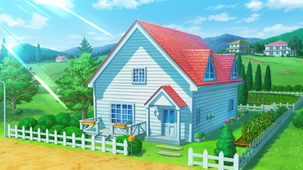
|

|
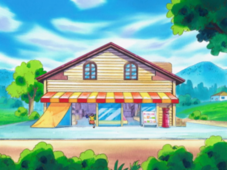
|
Pokémon Origins

Pallet Town in Pokémon Origins
Pallet Town made a couple of appearances in Pokémon Origins, being the hometown of Red and Blue. It first appeared in File 1: Red, where both Red and Blue were seen receiving a Pokédex each from Professor Oak, after which they got to choose their starter Pokémon. Red chose Charmander, while Blue chose Squirtle to counter Red's choice. Afterwards, both Red and Blue departed Pallet Town and started gathering information on their Pokédexes.
Pallet Town's next major appearance was in File 4: Charizard, where Red returned to Professor Oak's Laboratory to tell him how he had completed his Pokédex, only to find out that Blue had been injured during a battle against an unknown Pokémon at Cerulean Cave, during which his own Pokédex had also gotten destroyed. Red soon understood that the mysterious Pokémon was, in fact, Mewtwo, a genetically enhanced version of a rare Pokémon called Mew. In order to add Mewtwo's data to the Pokédex, Red headed to Cerulean Cave, where he battled and, with extreme effort, successfully caught Mewtwo. During a small party held by Professor Oak to celebrate the completion of the Pokédex, Red realized that since Mewtwo was created from Mew, he still had to go find and catch Mew in order to make the Pokédex truly complete.
I Choose You!
Pallet Town appeared at the beginning of I Choose You!, set in an alternate timeline from the main series, as the hometown of Ash Ketchum.
Gallery
In the manga
Ash & Pikachu
Pallet Town appeared in Do Your Best Bulbasaur!! and Off To The Battle Frontier!!.
Gallery
The Electric Tale of Pikachu
As in the anime, Ash's hometown is Pallet Town in the The Electric Tale of Pikachu manga series. Professor Oak does not appear to live in Pallet Town full-time, as he is seen doing a field study of Clefairy in Clefairy Tale. It is, however, the hometown of Ash and Gary, as well as the current residence of Delia Ketchum and May Oak.
According to Gary, Pikachu are commonly found around Pallet Town.
Gallery
| Ash's house
|
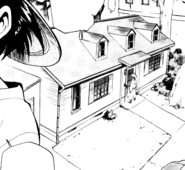
|
Movie adaptations
Pallet Town appeared in I Choose You!.
Gallery
Pokémon Adventures
History
Pallet Town was first seen in A Glimpse of the Glow, Bulbasaur, Come Home!, and The Secret of Kangaskhan as the hometown of the main characters Red and Blue, as well as the place where Professor Oak's Laboratory is located. It is also where Red caught a Nidorino when most of the children tried to catch it but didn't weaken him. The town also has a forest where Red and Blue saw a Mew whilst a group of Team Rocket Grunts tried to capture it. Later, in Kalling Kadabra, all the townspeople were kidnapped by Team Rocket and held hostage in the Silph Co. headquarters in Saffron City. Near the end of the chapter, it was revealed that Green was also born in Pallet Town.
Red saved a postman from his rampaging Ponyta. The postman had arrived at Pallet Town to deliver a letter to Red. Once it was clear that Red had disappeared after accepting the challenge written in the letter, Yellow came to Pallet Town and assumed guardianship of the Pikachu that ran back to Professor Oak's lab. Green had also found a new house in Pallet Town, and used it to monitor Yellow's progress.
Red and Blue briefly returned to Pallet Town. They received a recorded message from Professor Oak to deposit their Pokédexes in the Storage System, although this later turned out to be a plot set up by Team Rocket, who had kidnapped Professor Oak. Red's Saur and Blue's Charizard were briefly attacked by an invisible Pokémon before the two Trainers headed to Vermilion City and the Sevii Islands.
Gallery
Pokémon Pocket Monsters
Pallet Town is the hometown of Red and his rival, Green. Professor Oak also resides in Pallet Town, offering the two boys their choice of starter Pokémon, though Red chooses a Clefairy that he met on the way to the laboratory instead.
Gallery
Pokémon Zensho
Pallet Town appeared in Prologue: Pallet Town. Satoshi received his Charmander there at Professor Oak's Laboratory.
Gallery
Trivia
Origin
Pallet Town is based on Machida, Tokyo, Satoshi Tajiri's hometown.[1] However, its location on the map better corresponds to somewhere in the Shizuoka Prefecture.
Name origin
| Language
|
Name
|
Origin
|
| Japanese
|
マサラタウン Masara Town
|
From 真っ新 massara (brand new) or 真っ白 masshiro (pure white)
|
English, Dutch
Canadian French
|
Pallet Town
|
From palette, a range of colors used in various means
|
| French
|
Bourg Palette
|
From bourg (village) and palette
|
| German
|
Alabastia
|
From Alabaster, a white mineral
|
| Italian
|
Biancavilla
|
From bianco (white) and villa (estate; common city suffix)
|
| Spanish
|
Pueblo Paleta
|
From paleta, palette
|
| Korean
|
태초마을 Taecho Maeul
|
From 태초 (太初) taecho, beginning
|
| Chinese (Mandarin)
|
真新鎮 / 真新镇 Zhēnxīn Zhèn
|
From 真新 zhēnxīn , truly new
|
| 真新市 Zhēnxīn Shì *
|
From 真新 zhēnxīn , truly new
|
| Chinese (Cantonese)
|
真新鎮 Jānsān Jan *
|
From 真新 jānsān, truly new
|
| 純白鎮 Sèuhnbaahk Jan *
|
From 純白 sèuhnbaahk, pure white
|
| Arabic
|
قرية شورباك 'Qaryat Shoreback
|
The town of Shoreback
|
| Bulgarian
|
Град Паллет Grad Pallet
|
From English name
|
| Valencian
|
Ciutat Palet
|
From English name
|
| Croatian
|
Grad Pallet
|
From English name
|
| Czech
|
Oblázkové město
|
From oblázek' (pebble) and město (town, city)
|
| Danish
|
Pallet Town*
Paletby*
Byen Pallet*
Palette Town*
|
From palet (palette) and by (town)
|
| Finnish
|
Pallet Town*
Palleti kaupunki*
|
From English name
|
| Indonesian
|
Kota Pallet *
Kota Masara*
|
From its English name
From its Japanese name
|
| Icelandic
|
Palletbær
|
From English name
|
| Norwegian
|
Pallet Town*
Palletby*
Byen Pallet*
|
From English name
|
| Polish
|
Alabastia*
Alabastria*
|
From its German name
|
| Brazilian Portuguese
|
Cidade de Pallet*
Cidade Pallet*
Pallet Town*
|
From its English name
|
| European Portuguese
|
Aldeia Paleta
Pallet Town*
|
From paleta, palette
Same as English name
|
| Russian
|
Паллет Таун Pallet Taun
Алабастия Alabastiya*
Город Поддона Gorod Poddona*
|
From its English name
From its German and Polish name
Literally "Palette Town"
|
| Serbian
|
Grad Pallet
|
From English name
|
| Swedish
|
Pallet Town*
Palletstaden*
Staden Pallet*
|
From English name
|
| Thai
|
มาซาระทาวน์ Masara Town
|
Transliteration of its Japanese name
|
| Vietnamese
|
Thị trấn Masara
|
Transliteration of its Japanese name
|
References







